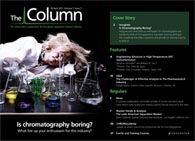Spark of life
In 1958 the University of Chicago zapped a simulated primordial earth atmosphere with a series of electrical discharges to demonstrate the way in which organic compounds may have been originally synthesized on Earth. Archived and unreported samples have recently been uncovered and submitted to modern analytical techniques, which have revealed even more abundant amino acid and amine yields than previous experiments.

In 1958, Stanley Miller, of the University of Chicago zapped a simulated primordial earth atmosphere with a series of electrical discharges to demonstrate the way in which organic compounds may have been originally synthesized on Earth. A set of archived and unreported samples has recently been uncovered and submitted to modern analytical techniques, which have revealed even more abundant amino acid and amine yields than any of his previous experiments.1
Miller’s classic experiments in the 1950s are recognized as the first efficient synthesis of organic compounds under primordial Earth conditions, providing a possible explanation for the origin of life. The original analysis was performed using paper chromatography with ninhydrin detection and the mixed melting point determination of derivatives to identify and quantify the compounds, but since then analytical sensitivity has increased by up to 10 orders of magnitude.
The discovered samples were subjected to HPLC–UVFD and UPLC–UVFD-TOF-MS, which identified a large assortment of amino acids and amines, and the relative yields of some are the highest ever found in a spark discharge experiment.
The gases used are thought to have potentially been prominent near volcanoes, a localized environment rich in lightning and steam, where the study concludes the gases could have played a vital role in the synthesis of some of the first terrestrial organic compounds.
1. E.T. Parker et al., PNAS, online (2011).
This story originally appeared in The Column. Click here to view that issue.

.png&w=3840&q=75)

.png&w=3840&q=75)



.png&w=3840&q=75)



.png&w=3840&q=75)











